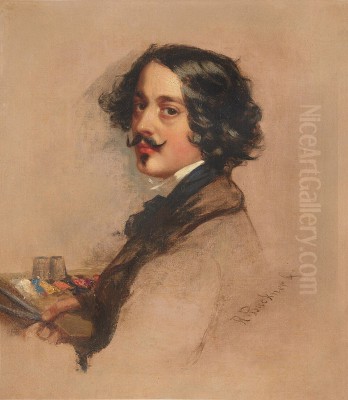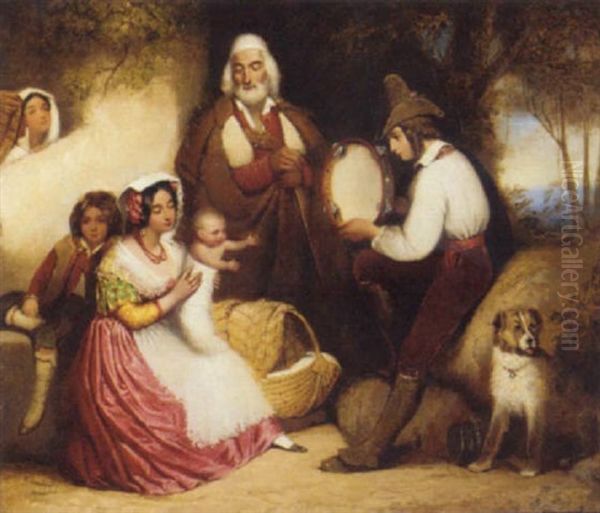
Richard Buckner stands as a notable figure within the sphere of 19th-century British art, primarily recognized for his refined and often sentimental portraits. Born during the Regency era and working through much of the Victorian period, his art captured the likenesses and aspirations of the British upper classes, often imbued with a distinct Italianate sensibility acquired during his formative years abroad. Though perhaps not an innovator on the scale of some contemporaries, Buckner carved a successful niche for himself, becoming a sought-after painter whose works graced the walls of aristocratic homes and major London exhibitions.
Early Life and Artistic Awakening
Richard Buckner was born on October 25, 1812, likely in Chichester, Sussex, England. He was the son of Lieutenant-Colonel Richard Buckner of the Royal Artillery. His early life included a period of military service, following a path not uncommon for young men of his standing. He served as an officer in the King's Royal Rifle Corps (the 60th Rifles). However, his inclination towards the arts eventually led him away from a purely military career.
Initially pursuing painting as an amateur, Buckner's passion and talent prompted a more serious commitment. A pivotal moment in his artistic development occurred between 1820 and 1840 when he spent considerable time in Rome. This period was crucial, as Italy, particularly Rome, was still considered an essential destination for artistic education and inspiration, drawing artists from across Europe and America.
In Rome, Buckner sought formal instruction, studying under the Italian painter Giovanni Battista Canevari (1789–1876). Canevari was known for his historical paintings and portraits, and his studio provided Buckner with technical grounding and exposure to the prevailing neoclassical and romantic influences within Italian art. This extended stay immersed Buckner in the art of the Old Masters and the contemporary Roman art scene, profoundly shaping his aesthetic preferences and technical approach.
Transition to Professional Artist

Upon returning to England, Buckner transitioned from an amateur enthusiast to a professional painter. He established a studio in London, residing for many years at 3 Cleveland Row, St James's, a location conveniently situated near the centres of society and art patronage. His background, combined with his evident skill in capturing a flattering likeness, positioned him well to attract commissions from the aristocracy and the affluent middle classes.
His professional career gained momentum through regular participation in London's major art exhibitions. These venues were critical for artists to display their work, gain critical notice, and secure commissions. Buckner became a frequent exhibitor, showcasing his paintings prominently and consistently over several decades.
He exhibited extensively at the Royal Academy of Arts in London, the most prestigious art institution in Britain. While sources sometimes differ on whether he achieved full membership as a Royal Academician (RA), his consistent presence at their annual exhibitions from 1842 until 1877 underscores his acceptance within the mainstream art establishment. His works were also seen at the British Institution and the Society of British Artists (Suffolk Street), further broadening his visibility. In later years, he also exhibited at the Grosvenor Gallery, known for showcasing more aesthetic and avant-garde works, suggesting a continued relevance even as artistic tastes evolved.
Artistic Style: Elegance and Italian Influence
Richard Buckner's style is characterized by its elegance, refinement, and a certain sweetness, particularly evident in his depictions of women and children. He excelled at portraiture, the mainstay of his career. His approach combined the polished finish and attention to detail favoured in academic painting with a sensitivity to capturing the sitter's social grace and idealized beauty.
The influence of his time in Italy is palpable in much of his work. This Italianate sensibility manifested in several ways. Often, his sitters, especially children, were depicted in Italian peasant costume or classical drapery, lending a romantic, picturesque quality to the portraits. Backgrounds might include Italian landscapes, architectural elements, or simply a warm, Mediterranean light. This infusion of Italian elements appealed to the romantic tastes of the Victorian era, offering a touch of the exotic and the classical.

Compared to some of his contemporaries, Buckner's work generally avoided the stark realism or intense psychological depth pursued by others. His focus remained on creating pleasing, socially acceptable images that celebrated youth, beauty, and status. His handling of paint was typically smooth, with careful attention paid to rendering luxurious fabrics, delicate complexions, and graceful poses. His colour palettes were often rich yet harmonious, contributing to the overall sense of opulence and charm. While capable of capturing a good likeness, his primary aim often seemed to be idealization rather than unflinching realism.
Portraiture: Capturing Victorian Society
Portraiture was the cornerstone of Buckner's artistic output and success. He painted numerous members of the British aristocracy and gentry, becoming a fashionable choice for those seeking elegant representations of themselves and their families. His portraits of children were particularly popular, often imbued with a sentimental charm that resonated with Victorian sensibilities regarding childhood innocence.
These portraits served not just as personal mementos but also as public statements of status and refinement. Buckner understood the social function of portraiture in his era and delivered works that fulfilled his clients' expectations for flattering and sophisticated images. He adeptly captured the elaborate fashions of the time, rendering silks, satins, lace, and jewellery with meticulous care, further enhancing the sense of luxury and social standing.
His sitters included prominent figures, although detailed lists can be difficult to compile exhaustively. His consistent exhibition record at prestigious venues like the Royal Academy indicates a steady stream of high-profile commissions throughout the middle decades of the 19th century. The demand for his work reflected his ability to navigate the tastes and expectations of elite Victorian society.
Notable Works and Representation
While many of Buckner's portraits reside in private collections, some examples can be found in public institutions, offering glimpses into his oeuvre. One specific work mentioned in the initial prompt's context, though potentially confused with another artist in that text, is the Portrait of William Graham Vivian (c. 1860). Attributed to Richard Buckner (1812-1883), this oil on canvas painting (127 cm × 101.3 cm) is held by the National Library of Wales. Assuming this attribution is correct for the painter in question, it would represent his work capturing male sitters, likely showcasing the same attention to detail and refined execution found in his other portraits.
Beyond this specific example, his body of work largely consists of portraits whose titles often simply identify the sitter (e.g., Portrait of Lady X, The Children of Lord Y). He also painted genre scenes, often with Italian themes, such as figures in traditional costume or scenes inspired by his travels. These works allowed for greater narrative or picturesque elements than formal portraiture. Titles like An Italian Mother and Child or Roman Peasants likely featured among his exhibited works, capitalizing on the popular fascination with Italy.
His work is represented in various collections, though perhaps not as ubiquitously as some other Victorian painters. Researching specific museum databases (like the National Portrait Gallery, London, or regional UK galleries) may reveal other attributed works, often featuring members of notable families from the period.
Context within Victorian Art
To fully appreciate Richard Buckner's position, it's essential to place him within the dynamic and diverse landscape of Victorian art. The era saw a multitude of artistic movements and styles coexisting, from the high academicism of the Royal Academy to the radical challenges of the Pre-Raphaelite Brotherhood and the burgeoning Aesthetic Movement.
Buckner operated comfortably within the more traditional, academic mainstream. His elegant portraiture can be seen in relation to other successful society portraitists of the time. Sir Francis Grant (1803–1878), President of the Royal Academy, was a leading figure in this field, known for his sophisticated equestrian portraits and depictions of the aristocracy. Franz Xaver Winterhalter (1805–1873), though German-born, was immensely popular with European royalty, including Queen Victoria, setting a standard for glamorous court portraiture that influenced many.
Buckner's style, with its smooth finish and idealized representations, contrasted sharply with the aims of the Pre-Raphaelite Brotherhood, founded in 1848. Artists like Dante Gabriel Rossetti (1828–1882), John Everett Millais (1829–1896), and William Holman Hunt (1827–1910) sought intense realism, vibrant colour, complex symbolism, and often drew inspiration from medieval and literary sources, rejecting what they saw as the formulaic conventions of academic art.
Other contemporaries explored different facets of Victorian life. William Powell Frith (1819–1909) became famous for his large, detailed panoramas of modern life, such as Derby Day and The Railway Station. Augustus Egg (1816–1863) tackled social issues through narrative paintings. Later in Buckner's career, figures associated with the Aesthetic Movement, such as James McNeill Whistler (1834–1903) and Albert Moore (1841–1893), prioritized formal qualities of colour and composition ("art for art's sake") over narrative or strict representation.
Academic painters like Frederic Leighton (1830–1896) and Lawrence Alma-Tadema (1836–1912) achieved enormous success with their highly polished depictions of classical or historical scenes, representing another facet of the established art world in which Buckner exhibited. Even within portraiture, George Frederic Watts (1817–1904) aimed for greater psychological depth and allegorical meaning in his "Hall of Fame" series, differing from Buckner's focus on social grace. John Singer Sargent (1856-1925), though representing a later generation, overlapped with Buckner's final years and brought a new bravura technique and psychological insight to society portraiture. Buckner's teacher in Rome, Giovanni Battista Canevari, also forms part of his artistic context.
Buckner's contribution lies in his consistent production of high-quality, fashionable portraits that perfectly suited the tastes of his clientele. He was a master of a particular type of refined, often Italian-influenced portraiture that held significant appeal during the mid-Victorian period.
Personal Life and Later Years
Details about Richard Buckner's personal life beyond his artistic career are somewhat limited in standard art historical accounts. It is known that he married Anne Hickson (likely verifying this against the conflicting information in the prompt's text which seemed to refer to a different Buckner). He continued to live and work in London, maintaining his studio in Cleveland Row for many years.
He remained active as a painter into the 1870s, continuing to exhibit his work regularly. His final exhibition appearance at the Royal Academy seems to have been in 1877, suggesting a winding down of his public career in his later years.
Richard Buckner passed away on August 12, 1883, in London. He left behind a substantial body of work, primarily portraits, that document the faces and fashions of Britain's upper classes during a significant portion of the Victorian era.
Legacy and Conclusion
Richard Buckner's legacy is primarily that of a skilled and successful Victorian portrait painter. He catered effectively to the demands of a wealthy clientele, producing elegant, idealized likenesses that combined technical competence with a fashionable, often Italian-inspired, charm. His popularity during his lifetime is evidenced by his long exhibition record at major London institutions and the numerous commissions he received.
While not generally considered a major innovator who drastically altered the course of British art, he represents an important aspect of the Victorian art world – the competent professional who met the market's demands for sophisticated portraiture. His work provides valuable visual documentation of the era's elite, reflecting their tastes, aspirations, and the prevailing aesthetic sensibilities.
His paintings, particularly those featuring children in picturesque Italian costume, capture a specific sentimental mood popular in the 19th century. The consistent influence of his Italian studies remained a hallmark of his style, lending a distinctive flavour to his work. Though perhaps overshadowed in art history by more revolutionary figures like the Pre-Raphaelites or later innovators like Whistler or Sargent, Richard Buckner remains a noteworthy artist whose career successfully navigated the currents of the Victorian art establishment, leaving behind a legacy of graceful and appealing portraiture. His work continues to be of interest to social historians and those studying the art patronage and tastes of 19th-century Britain.